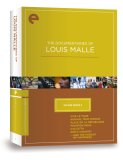| Reviews & Columns |
|
Reviews DVD TV on DVD Blu-ray 4K UHD International DVDs In Theaters Reviews by Studio Video Games Features Collector Series DVDs Easter Egg Database Interviews DVD Talk Radio Feature Articles Columns Anime Talk DVD Savant Horror DVDs The M.O.D. Squad Art House HD Talk Silent DVD
|
DVD Talk Forum |
|
|
| Resources |
|
DVD Price Search Customer Service #'s RCE Info Links |
|
Columns
|
|
|
Documentaries of Louis Malle - Eclipse Series 2, The
THE MOVIES:
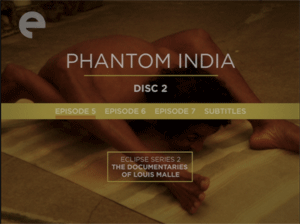
The best storytellers are the ones with a keen eye for human nature. Writers and filmmakers who deal in fiction usually fashion their most enduring tales out of smartly observed behavior, achieving a universality by using the realities of everyday life as their building blocks. Thus, it can often be interesting to see such creative minds turn their talents toward more journalistic pursuits.
The second entry in Criterion's Eclipse Series gathers together the best nonfiction efforts of one of film's most celebrated students of human behavior. The Documentaries of Louis Malle features seven movies on six DVDs. Malle is probably best known for his narrative efforts, including the memoir Au revoir les enfants and controversial sexual dramas Pretty Baby and Damage. He also enjoyed a second career as a documentary filmmaker, including the acclaimed crossover of his two passions, the surprising ode to the art of conversation, My Dinner With Andre. By putting Wallace Shawn and Andre Gregory together at a dinner table and filming them as they talked, Malle showed that a movie built on two people being themselves could have just as intense a character arc as the cast of a densely plotted fiction. The Documentaries of Louis Malle box set takes that same basic thesis and gives it a full and extended workout.
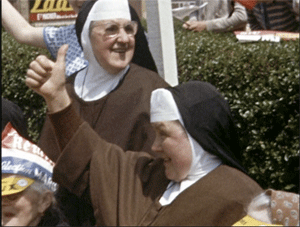
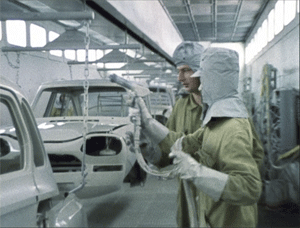
left to right: Vive Le Tour; Humain, Trop Humain
The lead disc in the collection has three of Malle's most down-to-earth films about modern life. It starts with 1962's Vive Le Tour, a 19-minute précis on the Tour de France. The director's approach anticipates Kon Ichikawa's redefining of the sports film, Tokyo Olympiad, by three years, looking at all the things that go on around the sports event rather than sticking to the basic outline of the race itself. Malle's impish eye is far more interested in the crowds that line the cycling route, the motorcycles that follow the competitors, and the stragglers at the back of the pack than he is the champions who lead it. His humorous narration underscores his irreverent visual style, settling on the cyclists' booze raids with a gleeful wink before shifting his scornful gaze to the racers who drop out of competition because of their reliance on performance enhancing drugs. It's by shuffling up these disparate elements that Malle creates a completely new portrait. Like a tarot reader, he's trying to finds the links between each piece and map out the greater territory of life.
This same impish quality is what allows Malle to make a 72-minute portrait of an automotive factory and call it Humain, Trop Humain (Human, All Too Human (1973)). The majority of the movie takes place inside the construction plant, silently moving from one-spot on the assembly line to another, lingering long enough for the pattern of repetition to register before cutting to the next. At each post, he doesn't just look at the action being performed, but at the face and hands of the person performing it, as well. You'd think this would get boring after a while, but it remains strangely mesmerizing. Each job has its own rhythm and each rhythm is represented not just by movement, but its own unique noise. The visual and the aural work together to create a kind of industrial symphony. Malle only leaves the factory once. About twelve minutes into the film, he cuts over to an auto show where the car manufacturers shill their product to a rabid public. This is the only sequence with any audible dialogue, as the sellers and the buyers make fast work of verbally taking apart what the army of workers has put so much effort into putting together. Malle imposes no narration on his imagery, letting the footage speak for itself. The only commentary he makes is in the title, and once he places the scenes of consumerism in with the scenes of production, a meaning emerges. This auto factory is the human endeavor in microcosm: what the everyday people come together to create, the money people come together to either devalue or profit from. Amazingly, Malle avoids any such exploitation himself. By standing away from it, he shrewdly lets his camera spin its own ballad of the working class.
Repetition and the everyday also come into play in the final film on DVD 1. 1974's Place de la République (95 minutes) is brilliantly simple in concept. Malle and his crew spend ten days on the same neighborhood block, openly filming and interviewing the people who live in and pass through the area. Some of the subjects, like the wig seller and the newspaper vendor, repeat from day to day, most are just one-off interviews. Malle is equally comfortable joking with a woman who fancies herself an actress or drolly questioning another lady handing out religious tracts. His bread and butter, though, are the people who respond to the microphone by talking freely about their lives. The best are usually the ones who refuse at first, but yet let themselves be seduced by the cinematic trappings, denying their desire to be involved all the way. Every person has a story, every person can be fascinating, it just takes a man like Malle to get them to open up. In doing so, he finds that no matter how diverse we are, life is a shared experience. Most people face the same problems, feel the same joy, we're just too busy being ourselves to see it.
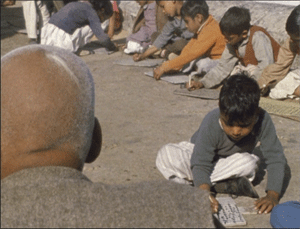
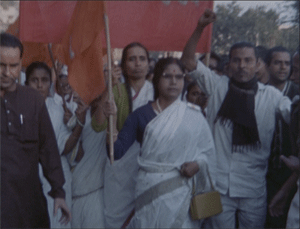
Phantom India; Calcutta
Though the first three films are all about France, Malle's homeland, the director's interests are more international. In 1969, he turned his attentions to India, shooting the six-part television epic Phantom India (discs 2 & 3; 365 minutes) and the stand-alone film Calcutta (disc 4; 99 minutes).
There are seven episodes of Phantom India, and Malle states his intention from the get-go. By then current figures, only 2% of the population spoke English despite it being the country's "official" language. As this 2% were normally the ones who spoke to foreign cameras, the majority of India was left unrepresented. Taking his camera on the road with no greater thesis than to film what he saw, Malle hoped India would teach him about itself. In his narration, he explains how he and his crew encountered different scenes, and he wrestles with his own preconceptions, challenging himself to look past Western symbology and try to see the events at face value. This isn't so easy to pull off, as he will always be an outsider. The camera will always be between him and the people he is observing. Early on, he points out how the culture is not yet inoculated to the presence of a film crew. Some people run from the camera, believing it will steal their souls; most of them engage the lens in a staring contest. Who will blink first?
Through the many shows, Malle tries to unravel the caste system, and he shows us weddings, festivals, work sites, institutions, art, nature, and even other Europeans trying to be a part of the culture. Overheard conversations are not translated for us, maintaining the same barriers our filmic host encounters. (When people speak in English, Malle translates their words into French, leaving his English-speaking viewers to read the subtitles of the same lines translated back into our language.) Some of the segments have themes (episode 3 is religion and spirituality, 5 is the caste system), and others use footage from a central location (Madras in episode 2, Bombay in 7) to build a more organic whole, moving from topic to topic via a loose structure. It's in those that he tries to find the particular rhythm of the region. Not every assessment he makes of the country is positive. Rather, Malle sees India as a land of contradictions, where every story has two or even three sides, and he tries to find a way to see them all. The result is as engrossing of an extended snapshot of a country as you're likely to get, managing to examine the observed and the observer in equal measure, what we look at being just as important as how we look at it.
Culled from the same pool of footage, Calcutta was put together as a theatrical release when Malle realized the city had enough of its own story to warrant a stand-alone feature. Also, as he presents it, Calcutta stands apart from the rest of India, an anomaly created by the British colonialists as a base of operations that had become culturally and economically lost when independence came. The economic divide is staggering, as wealthy Indians and remaining Brits watch horse racing in the shadow of a palace-like monument to Queen Victoria, while nearby, people are living in shantytowns. Here, the director is definitely making a judgment call, juxtaposing images for effect, and focusing on the particulars of societal neglect. This is forgivable, as it would be almost criminal for him not to say anything about it. At the time Malle is in the city, the competing Communist parties had just been unseated through political maneuvering, going against the popular vote and further disenfranchising the people. To counter the protests, Parliament made it against the law for more than five people to assemble at one time. It's somewhat ironic, given how densely populated Calcutta is. From the looks of the street scenes, it would have been hard to step out of your house and not be part of an assembly larger than five people.
Even so, immigrants still pour into the city, particularly from Pakistan. This despite there being far too many new people for the town to employ (a problem that will come up again nearly twenty years later in one of Malle's American documentaries). It's amidst this turmoil that Malle seeks out life, looking for how it carries on despite the crushing weight of Calcutta's problems. He manages to capture the full scope of it, showing us both a Hindu funeral and a wedding. The two events are equally colorful and ostentatious, and both signify new beginnings. In what Malle sees as a country full of paradoxes, Calcutta perhaps personifies India's most pronounced contradiction. Even as the skies grow darker and darker, they are always expecting the sun to return.
Then again, maybe that's not a contradiction at all. Maybe that's just the human spirit at work. It's something that all of Louis Malle's documentaries search for, regardless of where he is geographically.

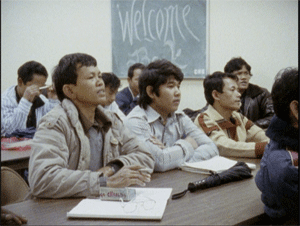
God's Country; ...And the Pursuit of Happiness
Once Louis Malle moved to America, it was probably only a matter of time before he turned his camera on his new home. In this day and age, pundits would probably have a hard time believing that a French filmmaker could make a documentary about the American Midwest that is completely absent of snark, but in his double-shot of the heartland, Malle applies the same non-judgmental techniques to our citizenry as he did everywhere else. When it comes down to it, it's probably less likely for a non-native to examine the "common folk" of the U.S. with disdain than it would be for most of our homegrown directors. In fact, it's probably Malle's immigrant status that makes him so interested in the ethnic background of the residents of the mainly German Minnesota town he explores in his 1985 PBS feature, God's Country (89 minutes). Malle begins his journey in 1979 by seeking out the local color of special events like proms and area fairs, but the people he meets on his travels make him just as interested in the simplicity of their day-to-day concerns. In Glencoe, improper lawn care is a more worrisome crime than the prospect of muggings. Malle immerses himself in the populace, seeking out its variety and showing people with differing points of view, quietly busting preconceived notions about people in the Midwest all being the same. Though some opinions about race and views of religion are less than progressive, they also aren't the only ideas expressed, and no one is vilified in Malle's editing room. (Talking to different gender representatives of the single life is quite illuminating, actually, given how lassez faire both sides are, and also how far apart they are at the same time.)
One thing that emerges in God's Country is a sense of continuity. Perhaps that's why the ethnic make-up of pieces of Glencoe ends up being important. The businesses and the families in the town have deep roots in the community, and their way of life is directly connected to the land they live on. Malle also discovers that traditional farming is not the only thing that pays the bills anymore. Many of the residents double-up on work, being employed in the local bank, for instance, as well as taking care of livestock. There is also some continuity to the previous films. The assembly line of a slaughterhouse is just as fascinating to Malle as the autoplant of Humain, Trop Humain. It's also cause for Malle to ponder what is happening to such community-driven endeavors in our modern world. Banks and business concerns are picking apart the American farmer just as French car buyers picked apart the fruit of the autoworkers' labor.
When the director returns to Glencoe six years later, in 1985, he finds some of that continuity intact. Some of the people have kept going full-steam ahead, and many of the places look just the same. Others have moved on, grown, and moved with the flow of life. Yet, they move with the same genial attitude. Of course, things staying the same means bad news persists, too, and the farmers still face the same economic problems, an issue that consistency doesn't benefit. It's here where change can't be fended off, and Malle has a lot of sympathy for the workers who are finding that their vocation is getting away from them--though, it's hard to stand with the Anti-Semitic business owner who predicts armed revolution a la George Washington. Thankfully, history shows he wasn't as prophetic as he thought. That all of these questions are ones that persist into the new century, however, is scary to think about.
The questions Malle raises about immigration in his 1986 film ...And the Pursuit of Happiness (81 minutes) will also sound familiar for anyone keeping an eye on current events. A lot of what is said in this documentary is still being said today, including rhetoric about protecting our borders and the accusations of immigrants coming in and taking employment away from the country's legal citizens. (And, like in Calcutta, Malle finds that the influx of Mexicans into various border towns is causing them to take jobs from each other, a byproduct of the problem that I've never really heard discussed.)
As with his other films, Malle's journey is almost completely unplanned. He travels to all the corners of America to see what different representations of immigration he can find. His subjects come from every continent except Australia, and include people from all walks of life: clergy, entertainers, laborers, businessmen, homemakers. What fascinates Malle the most is what people will do to assimilate and how that effects their success in the country. An Indian family, for instance, accepts most aspects of American culture, but they still maintain their religious views. A Costa Rican astronaut is the first NASA crewmember to go into space that isn't native born, but he still maintains his dual citizenship and considers himself as having two homes. Really, just about everybody keeps one foot in their new country and another in their old one, be they Russian, Korean, Cuban, Greek, Ethiopian, or Vietnamese. It's not that they don't appreciate the opportunities America affords them, but they see part of the American dream as being able to pursue their livelihood while still being who they are. Where else but America, for instance, could over 100 cab drivers from many different countries form a company together where they each own an equal stake in the business?
As with all of the stories in this set, however, it's not all roses. Beyond the questions of work and the legality of their immigration status, each immigrant must deal with the culture shock of his or her new home and how it not only affects them, but the generations of children who are now being born here that have no memory of where their families come from. Like always, Malle shows the many sides of his topic. While an El Salvadoran family fleeing political persecution that left their patriarch crippled runs afoul of the U.S. legal system, a Vietnamese doctor is completely accepted and thrives in an all-white community in the Midwest. Malle's main fascination is with the humanity that connects all of us more than he is interested in driving home a point or suggesting solutions. Regardless of where he sets up his camera, be it in France, India, or the U.S.A., Malle is just filming people. The fact that the same problems pop up again and again in all of these movies isn't clever manipulation on the filmmaker's part. Rather, he's just tracing the thread that stitches us all together.
This love of the great communal experience is what separates Louis Malle from the current crop of post-Michael Moore documentarians. While the director's own political views aren't that difficult to divine from the seven movies in The Documentaries of Louis Malle, his personal feelings never supercede the purity of the presentation. From film to film, across multiple continents and decades, the only thing that constantly emerges about Malle is that his thirst for knowledge and understanding was never quenched. He always kept searching and was always open to the story being told to him rather than being the one to tell it. It's a remarkable achievement, a grand artistic restraint for someone who is often more heralded for the personality he brought to fictional motion pictures. Frankly, we could use another voice like his in the cinematic dialogue--a voice that's willing to shut up and let other people do the talking.
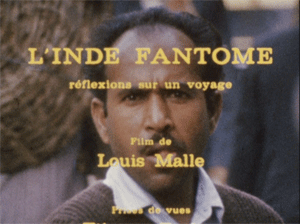
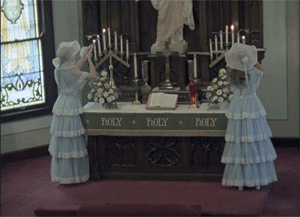
Phantom India; God's Country
THE DVD
Video/Sound:
All of the films in The Documentaries of Louis Malle – Eclipse Series 2 are shown in a full frame aspect ratio (1.33:1) and have a mono sound mix. Of the movies in the box, both God's Country and ...And the Pursuit of Happiness are in English, and the other five are in French with optional English subtitles. The seven features have gone through a very nice restoration process, preserving the naturalistic look and sound of the original footage. Some small glitches, like the occasional spec of dirt or stray hair, do show up, but these would appear to be a byproduct of the technology available at the time of filming and the nature of the shoot. In Phantom India, the picture shakes at various intervals, a momentary eruption that passes quickly. This is most prevalent in the first episode, which actually carries an apology at the end, noting that the source materials were not ideal for fixing every hiccup. It's also probably not a coincidence that the newer films look cleaner than the older ones. Overall, very conscientious DVD work here.
Extras:
Outside of liner notes in the individual cases for each movie (the discs come in slimline plastic holders inside a cardboard sleeve), there are no extras in the set. The Eclipse series is designed to be a reasonably priced collection of works by various directors presented as a bare bones package in order to bring the work to disc faster than the assembly of more complex DVD treatments would allow. Given the thematic grouping of the series entries thus far (the first was an anthology of formative Ingmar Bergman movies), it's a business model that I think works very well. If you feel every movie in your collection requires commentaries, deleted scenes, makings-of, and the like, then consider yourself warned.
FINAL THOUGHTS:
The Documentaries of Louis Malle – Eclipse Series 2 brings together an incredible run of movies that show the famous director traveling the world, letting his camera lead him and the people he met dictate the stories he would tell. Whether he was following bicyclists over the mountains of France, watching Hindu rituals in India, or talking to struggling farmers in rural America, Malle always leant his subject a sympathetic ear and viewed them with both eyes open. His style only gets more assured over these seven films, and there's not a stinker in the bunch. For the second in their new subdivision, Criterion nails it again. Highly Recommended.
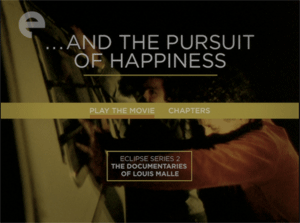
Jamie S. Rich is a novelist and comic book writer. He is best known for his collaborations with Joelle Jones, including the hardboiled crime comic book You Have Killed Me, the challenging romance 12 Reasons Why I Love Her, and the 2007 prose novel Have You Seen the Horizon Lately?, for which Jones did the cover. All three were published by Oni Press. His most recent projects include the futuristic romance A Boy and a Girl with Natalie Nourigat; Archer Coe and the Thousand Natural Shocks, a loopy crime tale drawn by Dan Christensen; and the horror miniseries Madame Frankenstein, a collaboration with Megan Levens. Follow Rich's blog at Confessions123.com.
|
| Popular Reviews |
| Sponsored Links |
|
|
| Sponsored Links |
|
|
| Release List | Reviews | Shop | Newsletter | Forum | DVD Giveaways | Blu-Ray | Advertise |
|
Copyright 2024 DVDTalk.com All Rights Reserved. Legal Info, Privacy Policy, Terms of Use,
Manage Preferences,
Your Privacy Choices | |||||||









